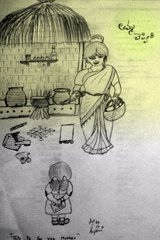Chinese aaku Pachadi/ Chinese Box-thorn Chutney
Set 1:
Red chillies - 25 no.
Coriander seeds - 2 tbsp
Urad dhal - 1 tbsp
Sesame seeds - 1 and 1/2 tsp
Cumin seeds - 1/4 tsp
*Fry these in little oil and powder in mixie.
Set 2:
Chinese aaku - 1 bunch (Pluck the leaves alone, wash well. Keep it on towel to dry out little)
Tamarind - lemon size (add enough water, until immersed. Microwave for 2 mins, cool, squeeze the pulp)
Salt as required
Oil - 2 tbsp
*Heat Oil in a deep pan and fry the leaves till it shrinks. Add tamarind juice and cook it until it becomes thick. Keep aside until cools down.
*Transfer this to the above mixie jar and add salt to taste, grind this into paste. Check for tartness and salt. Remove the grinded paste into a tiffin box.
Set 3 (seasoning):
Oil - 2 tbsp
Mustard seeds - 1 tsp
Red chillies - 4 no. (split them)
Asafoetida - little
*Fry these in heated oil and add it to the above chutney, mix well and serve.
Serve with Chow Chow Dal, Rice and Yoghurt on side.
Tip:
Tastes good the next day. If you need more chillies for hotness, don't hesitate to add. Personally it needs more.
It got very subtle taste, so need tamarind juice bit more. Do try! some times I just eat it with ghee. Keep refrigerate........
Meaning:
Chow chow = Ban-galore vankaya
Box-thorn:
is a plant native to China and Japan, but it also grows in parts of tropical Asia where it is particularly appreciated by the Chinese. The stiff stems are known in Chinese as the "walking stick of immortals", no doubt a reference to the plant's medicinal properties. Both the fresh leaves and ripe berries (often known as wolf-berries) are eaten, the dried berries being one of the most popular items in the Chinese pharmacopeia and in use for at least 2,000 years. Chinese box-thorn should not be confused with the noxious weed, African box-thorn, a native of South Africa which has been grown as a decorative plant in Europe, Australia and America.
Appearance & Flavor The plant has somewhat oval, dark green leaves growing closely together from a very stiff, almost woody stem which has sharp spines well hidden where the leaf stems join the central stem. The stems are usually 10 - 12 in (25 - 30 cm) in length when sold in markets. Choosing & Storing Box-thorn is sold with the leaves still on the hard stems. Look for leaves which have not wilted. Do not remove the leaves from the stem until just before cooking. To store, wrap in kitchen towels and refrigerate for 4 - 5 days. Preparing When removing the leaves from the stems, be careful to avoid the short, sharp spikes hiding on the stem - remember the word "thorn" in the name of this plant. Rinse the leaves and drain. Nutritional & Medicinal Properties Both the green leaves and the ripe red berries (sold dried in Chinese medicine shops and in herbal mixtures in Asian stores) are said to be good for the liver. The leaves are rich in calcium and iron, while the berries contain carotene and vitamin C, and are regarded as a general tonic, as well as being good for eyesight. Culinary Uses Box-thorn is generally cooked in soups by the Chinese, often with pork or pork liver. As the leaves are slightly bitter, dishes with box-thorn often need a touch of sugar to counteract the bitterness, as well as a dash of white pepper for fragrance. The dried berries have a pleasant sweet-sour flavor and are often added to soups such as clear chicken stock. Wolf-berries can also be added to stir-fried vegetables for color and texture ( by Wendy Hutton - A Cook's Guide to Asian Vegetables).
In other languages...........
© 2008 by Rajani Rayudu

